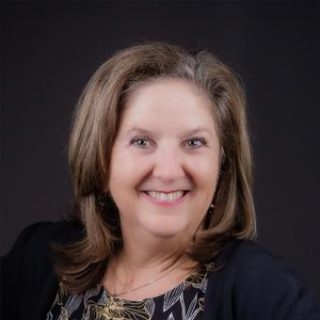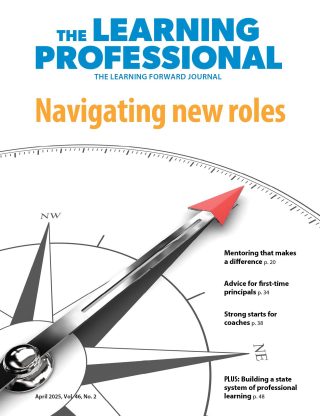IDEAS
No counselor left behind
Don't overlook these highly qualified professionals in your learning plans
By Mandy Savitz-Romer
June 2019
Vol. 40, No. 3
If your district or school has developed a strategic plan for professional learning, implements strong coaching and PLCs, and aims to meet the Standards for Professional Learning, you may believe you are covering all the bases to build capacity in your staff. But look more closely. Are you including all the professionals who influence learning and academic success?
Too often, leaders overlook valuable human capital in their schools and miss the opportunity to develop them so that the school and its students can reach their full potential. This is particularly true for a highly qualified but underused group of professionals: school counselors. Too often, leaders overlook valuable human capital in their schools and miss the opportunity to develop them so that the school and its students can reach their full potential. #LearnFwdTLP Share on X
School counselors work at the nexus of academic, social and emotional, and post-secondary development. They are uniquely positioned to support students’ skills, address barriers to learning, and support schools’ strategic priorities.
However, with growing responsibilities, counselors report needing more knowledge and skills to support students, staff, and families. Initially introduced into schools to provide vocational guidance and post-secondary direction to students, today’s school counselors are asked to do much more: to deliver a comprehensive program to support students’ academic, social and emotional, and post-secondary development.
Yet professional learning for school counselors is often an afterthought, in stark contrast to a common districtwide commitment to professional learning for teachers. And with limited access to professional conferences, school counselors are left with few opportunities to expand their skills once they enter the field or keep pace with new demands placed on schools.
Making matters more difficult, this gap is occurring at a time when many counselors work under difficult conditions that include exorbitantly high caseloads, ambiguous role descriptions, and overwhelming administrative responsibilities.
Bringing counselors into the fold of high-quality professional learning can lead to more efficiency, consistency, and support for teaching and learning. This means making a commitment to professional learning for counselors and aligning it with larger strategic goals while acknowledging counselors’ unique roles, strengths, and needs. Bringing counselors into the fold of high-quality professional learning can lead to more efficiency, consistency, and support for teaching and learning. #LearnFwdTLP Share on X
LOCATE THE PROFESSIONAL LEARNING GAP
The reasons for counselors’ lack of access to professional learning are numerous and varied.
Many counselors are required to attend school-sponsored professional development that has little relevance to the role they are expected to fill. Ask any counselor, and most will describe attending learning experiences focused on instructional practices and classroom strategies with no effort to connect those strategies to their own work with students.
Finding relevance in these sessions can be particularly difficult when they are conducted at the district level, because counselors’ needs vary by school demographics and students’ challenges. For example, whereas some counselors need updated learning to support students exploring their sexual identity, others need opportunities that equip them with skills to consult with teachers on implementing positive behavioral interventions or mentoring students to encourage college or careers.
Costs, both financial and opportunity, are also barriers to professional learning for counselors. Many professional learning opportunities sponsored by national organizations are costly and require time away from work. The financial costs of professional learning are especially hard on counselors in rural and urban school communities, whose districts lack funds for counselor attendance.
In many instances, school counselors are not permitted to attend conferences due to concerns by administrators about insufficient funds or not having coverage when counselors are absent. Unlike teachers, counselor absences are not compensated for with substitutes. This can hinder schools’ ability to respond to crises, and, for counselors, it often means that work piles up while they are gone. For these reasons, many counselors don’t consider time away for professional learning worthwhile.
Beyond content and access, counselors often experience the outdated sit-and-get or one-and-done model of professional learning, both of which have limited impact on improved practice. This type of learning is further complicated by the fact that even when counselors learn new skills and ways of working, they are limited in their ability to apply their new knowledge because school leaders do not understand or support these practices or have a different set of expectations for how counselors should spend their time.
Together, these factors form a formidable barrier to accessing professional learning. School counselors who do not access professional learning risk languishing in their roles and missing the chance to connect their work to larger school goals. Worse, students miss out on much-needed supports.
SET A NEW VISION FOR SCHOOL COUNSELORS
Because school counselors can be a valuable resource to tackle education’s most pressing issues, including college and career readiness, it is time to invest in counselors’ learning. A new approach requires recognizing that the counseling responsibilities of today differ dramatically from the outdated role of yesterday. A new approach to school counselors learning requires recognizing that the counseling responsibilities of today differ dramatically from the outdated role of yesterday. #LearnFwdTLP Share on X
School counselors, at all levels, teach study skills that enable students to be successful in classrooms and identify barriers to learning that can be addressed by supplemental supports. Counselors in middle and high schools help students draw connections between classroom learning and future goals. In fact, research has found that when students are clear about a future path for themselves that feels doable and reachable, their academic engagement increases.
School counselors also play a key role in helping students develop social and emotional skills like goal setting, planning, and managing emotions. Importantly, counselors also help students manage family and social stressors so that they can focus in school and achieve their best. All of these supports are vital for student success and, too often, they don’t fit into the time or experience of many classroom teachers.
I believe that a new vision for school counseling should draw on the medical home model popularized in health care (Savitz-Romer, 2019). As primary care providers are the first check-in point and coordinate care with specialists, school counselors should be at the center of students’ development, providing an academic home and then building on it and leveraging other valuable resources inside and outside of schools.
This approach calls on counselors to act as leaders in schools, creating a web of supports that draw on the contributions of teachers, community partners, families, and students themselves.
MEET COUNSELORS’ PROFESSIONAL NEEDS
This new vision requires an update to professional learning for school counselors, one that takes an ecological approach to professional learning that includes not just what is covered in learning opportunities, but also who is included and how it is accomplished. School and district leaders can draw on the following models — some of which already exist in their schools — to engage school counselors.
Counselors in middle and high schools help students draw connections between classroom learning and future goals.
Data-driven professional learning. Because counselors’ needs vary, it is important for professional learning directors to use surveys to identify what needs are a priority in any given year and align this data with larger school priorities and plans.
Whereas one school might be struggling with social media usage, another might need support identifying signs of suicide. Another school might discover that, although the school has a goal of preparing all students for college, counselors aren’t sure how to help students who are struggling in their coursework.
From this data, district leaders can tailor professional learning to both districtwide goals and counselors’ unique role and responsibilities. For example, a district concerned with absenteeism might engage counselors in identifying how they can be leveraged to improve students’ attendance and engagement. In one school district, counselors proposed a home visit program in which they alternated days of the week to visit homes, while their colleagues covered at school. This initiative not only improved attendance, but also sent a strong signal to the counselors about their value in the district.
Cross-role teams. For school counselors to adopt a new approach to their work, their role partners need to better understand the counselor’s role and the collaborative relationships needed to realize it.
Counselors often report poor relationships with leaders, teachers, and other school staff because of general misperceptions of their role. A common refrain counselors hear from their colleagues is, “What do counselors actually do?” Shared professional learning is a great way to clarify these varied roles and forge important relationships.
To accomplish this, schools, districts, and professional organizations should look to cross-role learning opportunities. For example, schools might create cross-role professional learning that brings together counselors and teachers for shared learning on topics of shared interest, such as behavioral interventions and support.
Districts might also host learning experiences that bring together counselors and school leaders to work in partnership to implement changes in their schools. For example, some districts have introduced counselor-principal agreements that set up counselors and school leaders to set school counselors’ yearly goals and identify support needed for counselors to meet these goals.
Not only can these professionals collaborate more effectively when they experience learning together, but it helps each role partner understand one another’s strengths.
PLCs. Just as professional learning communities (PLCs) have been used to engage teachers, they can be used for counselors to facilitate collective inquiry and action research to better support the students they serve (DuFour, DuFour, Eaker, & Karhanek, 2004). Counselors can be a valuable addition to PLCs with other educators, so that they are supporting larger school goals. ''Just as #PLCs have been used to engage teachers, they can be used for school counselors to facilitate collective inquiry and action research to better support the students they serve.'' #LearnFwdTLP Share on X
Young, Millard, and Kneale (2013) call for the implementation of school counseling collaborative teams formed by counselors in a given school, counselors from feeder elementary or middle schools working together, counselors from a geographic area, or counselors with a shared interest in gaining specific skills. This can be an especially useful way to improve the transition between elementary, middle, and high school because the relationships formed among counselors serve as a bridge for students’ transitions.
Engaging professional associations. Professional organizations also have a vital role to play in closing the learning gap for counselors. Professional organizations targeting different roles (e.g. school principals and school counselors) might host shared learning opportunities that bring together the standards that guide each profession to create collaborative approaches to pressing issues in schools.
Professional organizations that support these role partners can invite school counseling leaders and associations to present at their conferences and participate in ongoing networks to educate their members about the contribution of school counselors.
Professional organizations that provide the majority of learning opportunities for counselors, such as the American School Counselor Association and the National Association for College Admission Counseling, can play a key role in creating this continuity. They could adopt Learning Forward’s Standards for Professional Learning as sustained, job-embedded, and collaborative. These standards could guide coaching models supported by these professional associations as well as other professional learning opportunities and networks they sponsor.
Structures and systems. Creating academic homes where counselors can lead collaborative approaches to promoting students’ development will depend on new structures and systems to guide that home. Counselors will need help creating the systems and processes to guide an academic home, such as developing memoranda of understanding to manage partnerships or data tools to identify gaps in programming.
Professional organizations also have a vital role to play in closing the learning gap for counselors.
For counselors whose days can be filled with one immediate crisis after another, professional learning must include time and technical support to create these tools and systems. Much like literacy coaches have been used to help literacy instructors improve their practice, school counselors would benefit from coaching and intermediary support to help them build the systems (e.g. data systems, teams, protocols) that will help an academic home run smoothly. Professional learning directors might also use boot camps and other learning experiences that are focused on deliverables and support counselors’ work time.
External learning opportunities. Because counselors’ work is connected to external partners, including colleges and employers as well as mental health services, it can be valuable for them to engage in professional learning opportunities in those settings, where they can learn firsthand about these settings and collaborate with the professionals who work in them.
For example, high school counselors, who spend a lot of their time educating students about post-high school career and college pathways, can participate in externship programs to learn about the job pathways in their community.
Through visits to colleges and universities, counselors can learn about what colleges are looking for and how the school can prepare students; support programs the universities offer, for example to first-generation college-goers; and their former students’ experiences to inform how they prepare current and future students.
For example, one school district gave counselors time off to visit graduates in college. This allowed the counselors to learn more about the institution through the eyes of one of their graduates so they could help school staff understand what high schoolers really need to know and do to be prepared while also giving the graduate an additional dose of support during a critical transition time.
INVEST IN COUNSELORS’ READINESS
All students should have access to well-trained school counselors who have the skills and knowledge necessary to support the full range of academic, social and emotional, and post-secondary needs. For that to happen, we need to make a firm commitment to supporting counselors’ professional learning needs.
If counselors are to provide students an academic home and coordinate the supports of many partners, professional learning will need to be a shared responsibility across schools, districts, and the broader professional learning community.
Want to hear from the author and other educators about this topic? Check out the recap of a Twiter chat that was based on this article.
School counselors are uniquely positioned to support students’ skills, address barriers to learning, and support schools’ strategic priorities.
References
DuFour, R., DuFour, R. Eaker, R., & Karhanek, G. (2004). Whatever it takes: How professional learning communities respond when kids don’t learn. Bloomington, IN: National Education Service.
Savitz-Romer, M. (2019). Fulfilling the promise: Reimagining school counseling to advance student success. Cambridge, MA: Harvard Education Press.
Young, A.A., Millard, T., & Kneale, M.M. (2013). Enhancing school counselor instructional leadership through collaborative teaming: Implications for principals. NASSP Bulletin, 97(3), 253-269.
Recent Issues
LEARNING DESIGNS
February 2025
How we learn influences what we learn. This issue shares essential...
BUILDING BRIDGES
December 2024
Students benefit when educators bridge the continuum of professional...
CURRICULUM-BASED PROFESSIONAL LEARNING
October 2024
High-quality curriculum requires skilled educators to put it into...
LEARNING TO PIVOT
August 2024
Sometimes new information and situations call for major change. This issue...












